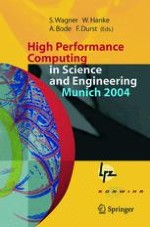2005 | OriginalPaper | Buchkapitel
High-Performance Computing in Turbulence Research: Separated Flow Past an Airfoil at High Angle of Attack
verfasst von : Nikola Jovičić, Michael Breuer
Erschienen in: High Performance Computing in Science and Engineering, Munich 2004
Verlag: Springer Berlin Heidelberg
Aktivieren Sie unsere intelligente Suche, um passende Fachinhalte oder Patente zu finden.
Wählen Sie Textabschnitte aus um mit Künstlicher Intelligenz passenden Patente zu finden. powered by
Markieren Sie Textabschnitte, um KI-gestützt weitere passende Inhalte zu finden. powered by
The paper is concerned with the prediction and analysis of the turbulent flow past an unswept NACA-4415 airfoil at high angle of attack. The predictions were carried out using large-eddy simulations (LES) applying two different subgrid-scale (SGS) models, namely the Smagorinsky model and the dynamic model by Germano/Lilly. For this kind of flow simulations high-performance computers such as the presently used SMP cluster Hitachi SR8000-F1 are inevitable. The Reynolds number investigated is
Re
c
= 10
5
based on the chord length
c
of the airfoil. An inclination angle of
α
= 18° was chosen. At these operating conditions, the flow past the airfoil exhibits a trailing-edge separation including some interesting flow phenomena such as a thin separation bubble, transition, separation of the turbulent boundary layer and large-scale vortical structures in the wake. Qualitatively the simulations with both SGS models predict the aforementioned flow features in a similar manner. However, looked at closely, some noteworthy differences become evident. The most striking one concerns the shape and influence of the separation bubble. In the simulation with the Smagorinsky model the separation bubble is predicted more than twice as thick as by the dynamic model. This also influences quantitative values such as the distribution of
C
p
,
C
f
or the turbulent kinetic energy. The largest discrepancies between the results of the two models applied are found to be close to the wall. Therefore, the SGS models have to be examined with respect to their reliability in predicting the near-wall region of a flow. In addition, the paper aims at a deeper insight into the nature of turbulent separated flows. This is done by analyzing the simulations according to the anisotropy-invariant theory which is expected to provide an improved illustration of what happens in a turbulent flow. Therefore, the anisotropy of various portions of the flow was extracted and displayed in the invariant map in order to analyze the state of turbulence in distinct regions. Thus, turbulence itself as well as the way it is developing can be investigated in more detail leading to an improved understanding of the physical mechanisms.
